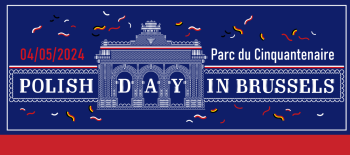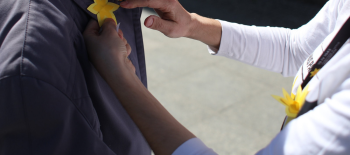The pianist, composer and pedagogue Józef WIENIAWSKI is one of the greatest musicians to have graced the end of the XIXth century in Europe. During his lifetime, he enjoyed glory and recognition; after his death, he was unjustly forgotten. Perhaps this can be explained by the fact that he started his career in the shadow of his older brother, the brilliant violonist and composer Henryk Wieniawski. Together, they played on the greatest stages in the world, and enjoyed tremendous success. In 1878, Józef Wieniawski set up home in Brussels where he became a piano teacher, composed and gave many concerts. He was also a great propogator of the music of Fryderyk Chopin, his favourite composer, and Stanisław Moniuszko.
It is on this extraordinary personality that the concert-conference will focus on 26 November 2016. The pianist Jacek KORTUS will pay tribute to him by playing a series of pieces which typify his work:
-
- Mazurek koncertowy (Mazourka de Concert) in D major, op. 41
- Barcarolle, op. 29
- Pensée fugitive, op. 8
- Valse de Concert, op. 3/1
- Piano Sonata in B minor, op. 22
The conference will be given by Prof. Renata SUCHOWIEJKO, director of the department of methodology and the history of music (19th – 21st century) at the Institute of Musicology at the Jagiellonian University in Krakow.
PRACTICAL INFORMATION
>>> Koninklijk Conservatorium Brussel, Concertzaal (rue de la Regence 30A, 1050 Brussels) – see map
>>> 26 November 2016 – 20:00
>>> FREE OF CHARGE. RSVP before 24 November (brussels@instytutpolski.org or +32 (0)2 554 06 90)
The concert and conference were launched jointly by the Polish Institute in Brussels and the Flemish Royal Conservatory of Brussels with a view to shining a light on Belgium’s shared cultural heritage.
The library of the Royal Conservatory of Brussels has preserved a large series of manuscripts signed by Józef Wieniawski, beqeathed by his daughter Elisabeth and currently archived in the Wieniawski fund. This bequest includes the Sonata for piano and violin (op. 20) and the Concerto for piano and orchestra (op. 24) dedicated to Leopold II of Belgium.
We also have Józef Wieniawski to thank for the famous “double piano with mirrored keyboards“, built by the Mangeot brothers, one of which can be viewed at the Brussels Musical Instruments Museum (MIM).
Born in Lublin on 23 May 1837, Józef Wieniawski died in Brussels on 11 November 1912. His body was buried in Ixelles cemetery. His tomb was restored in summer 2016 thanks to the combined efforts of the Polish Institute and the Henryk Wieniawski Musical Society of Poznan. This restoration work was paid for from funds from the Polish Ministry of Culture and Cultural Heritage. Now, one can read the quotation from the poem ‘Promethidion’ by Cyprian Kamil NORWID which the composer had asked to have engraved on his tomb.
+++ Read the summary report on the renovation and restoration work
The photographs can be found in the photo album below.
Project carried out thanks to the joint efforts of the Henryk Wieniawski Musical Society of Poznan and the Polish Institute in Brussels, co-financed by the Polish Ministry of Culture and National Heritage.
Born in Poznan in 1988, Jacek Kortus, winner of the first prize from the I. J. Paderewski Conservatory, is a teaching assistant in the piano department of this establishment. Since his teenage years, he has been playing on Polish stages and has won several competitions. He has also played in many European countries, in the United States, Mexico, Brazil, Chile, Japan, China, Israel, Palestine and Morocco. He is the recipient of several grants, notably from the Polish Ministry of Culture and National Heritage. His first solo album was released in 2008 (label “Muza Polish Recordings”), whilst his second album, recorded with Polish tenor Tomasz Zagorski, was made in 2015.
The holder of a doctorate in Musicology from the Jagiellonian University in Krakow, she received a DEA (French postgraduate degree) from the University of Tours in 1995. Her thesis was awarded the Prime Minister’s Prize for the excellence of her work. Her post-doctorate also received an award from the rector of the Jagiellonian University. She was director of the Institute of Musicology of her alma mater from 2008 until 2012. At present, she is the director of the department of methodology and the history of music (19th – 21st century) at the same institute. We have her to thank in particular for:
- Henryk Wieniawski – kompozytor na tle wirtuozowskiej tradycji skrzypcowej XIX wieku [Henryk Wieniawski, Composer and the 19th Century Violin Virtuoso Tradition], Poznań, 2005 ;
- Henryk Wieniawski – wirtuoz w świetle XIX-wiecznej prasy [Henryk Wieniawski as Virtuoso According to the 19th Century Press], Poznań, 2011 ;
- “Henryk Wieniawski in America”, in : “Ad Parnassum”, April, 2005, pp. 45–55 ;
- “Henryk Wieniawski’s Concert Performances in Russia”, in : “Fontes Artis Musicae”, January –March 2011, vol. 58/1, pp. 24–34 ;
- “Les violonistes virtuoses et la presse au XIXe siècle : épistemologie d’une recherche à partir de l’exemple de Henryk Wieniawski”, in : En pèlerinage avec Liszt: Virtuosos, Repertoire and Performing Venues in 19th-Century Europe, ed. Fulvia Morabito, Turnhout 2014, pp. 279-300
Renovation and restoration work, summer 2016
Józef Wieniawskis tomb was built from a Belgian marble typical of the region, in the form of a simple obelisc decorated by a bas-relief representing an angel, a portrait of the deceased and an inscription. One can also find molded parts in the bronze. The relentless wear and tear of time led the materials to deteriorate, changing the aesthetic effect of the monument. The black marble had lost its shine, becoming matte with a grey hue. The bas-relief features and other features in bronze had, nevertheless, taken on this characteristic patina which gives them a beautiful greenish colour. As a result of these atmospheric conditions, the stone had become covered wih a multitude of cracks, which also allowed the increased growth of microorganisms.
The restoration and conservation work carried out in 2016 by Piotr Niemcewicz’s team aimed to limit the deterioration of the monument and give it all its artistic and aesthetic value. The work had several stages: eliminating the products of corrosion, eliminating the stratifications to which the stone and the metal had fallen victim, disinfection of the elements, replacing missing elements and polishing the matte marble. Moreover, the metal was protected by adding a malachite patina. The inscription, which had been rendered illegible, was also cleaned, re-engraved and burnished. The final stage consisted of reinforcing the foundations and coating the monument with waterproof products.
The tomb thus took on its orignal aspect once more. Erasing the corrosive products gave the marble back its initial colour, which highlights even more the bronze elements coated in malachite patina. If the tomb’s appearance was altered by the renovation and conservation work, the quality of the materials was also brought out, thus underscoring the high artistic quality of the object.
(Text written by Piotr Niemcewicz, Faculty of Fine Arts, Nicolaus Copernicus University in Toruń)
Links
Towarzystwo Muzyczne im. H. Wieniawskiego: http://www.wieniawski.pl
MKiDN: http://www.mkidn.gov.pl
Koninklijk Conservatorium Brussel: http://www.kcb.be/



